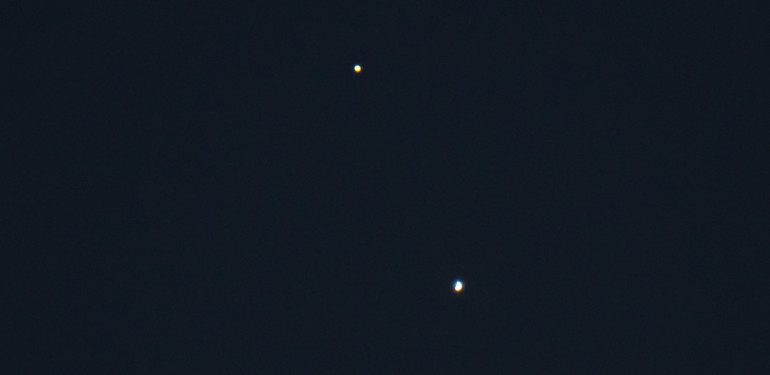Venus & Jupiter conjunction
In the last few days we had a chance (and still have) to observe one of the most interesting astronomical phenomena of 2015: a conjunction of Venus and Jupiter. Both planets reached the closest distance between on 30th June and, though they’re slightly increasing the distance each day, can still be observed in the same part of the sky in coming days.
These two planets are very easy to spot even with naked eyes as two the brightest (just after the Sun and the Moon, of course) celestial objects. Can be seen in the evenings in the western part of the sky and even a simple binocular will transform them from bright points into small, but noticeable shapes. Jupiter will be round disc, with a pale-yellow tint, and depending on your equipment you might be even able to see some atmospheric details, like the Great Red Spot or two darker belts on both sides of Jupiter’s equator. Venus, even under low magnification, will reveal its current phase - because it’s orbiting closer to the Sun than Earth, the planet changes phases just like the Moon does. Now we have very favourable conditions to see these two planets together and it won’t happen again until the second half of 2016.
Although I’ve been observing Venus and Jupiter carefully for a few days now, I had planned special session on the last day of June, when the distance between planets was the smallest. I set up my position short after the dusk, starting with polar alignment of the equatorial mount. I use EXOS-2 mount (it’s Bresser’s equivalent to EQ5-class mount) with polar scope, so the operation itself took only 2 mins. Then I mounted my refractor - it’s fast (f/5) 5-inch achromat, therefore it’s not the best choice for planets (simply too bright, it is usually used for observing Deep Sky Objects, like nebulas, clusters, galaxies, etc); yet I didn’t have much choice since buying a second tube (5-inch or 6-inch catadioptric telescope for observing Solar System Objects) is only in my plans for the next year.
Short technical note: Fast achromatic refractors produce a specific distortion called chromatic aberration. If you had had contact with astronomy before it is very likely you already know what it is and how it influences images produced by telescope. If not, please let me navigate you to Wikipedia for detailed and simple explanation. Unfortunately chromatic aberration makes it difficult to produce well focused detailed photos of planets, so the featured photo you can see at the top of post shows some violet, blue and yellow glow around Venus’ partially visible disc. However, it’s not as annoying when you observe Deep Sky Objects and that’s what fast achromatic refractors are designed for.
Anyway, returning to the topic, after setting up my position and pointing telescope to two planets, I was able to see their discs even at 30x power. At 96x Venus phase was beautifully visible, and I was able to see all Galilean moons of Jupiter. I managed to take few shots of both planets using my DSRL in the primary focus of refractor. The photo was taken at 635 mm.

Conjunction of Jupiter and Venus.
I think it would be even better if not for the Moon in full phase - too much light from Sun after the sunset and additional light from moon rising up in the sky made it quite difficult to capture the beauty of the conjunction. But still, I’m quite happy with the result.